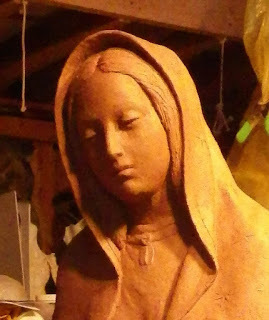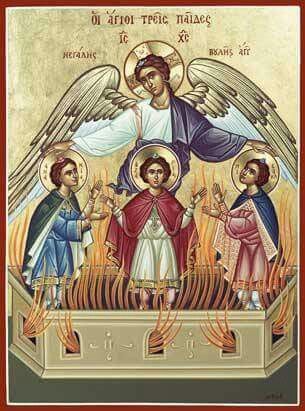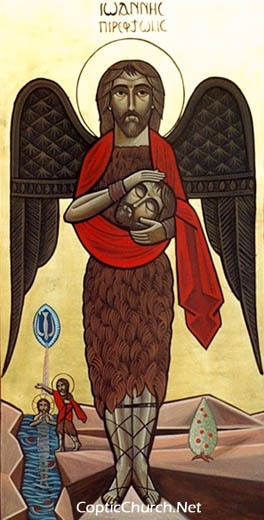David Clayton's Blog, page 5
December 26, 2017
The Fall of Adam and Eve by William Blake
Here is the third in the series of 12 short videos on art by Bill Donaghy of the Theology of the Body Institute in Philadelphia. I encourage all to investigate the courses they offer, by the way, which are available through their website.
Once again there are great insights here. Here is one little nugget to tempt you with, if you will forgive the pun, is the play on the word ‘adoration’. Bill explains how this word is derived from the Latin, ad-oratio, that is ‘to the mouth’. To adore is to love intimately – mouth-to-mouth contact – as the imagery of the root portrays. As we see in this painting, the destruction of the harmony between God and man is brought about by a perversion of this, in which Blake show a mouth-to-mouth temptation by the serpent. I suggest that the restoration of this harmony, brought about by Christ, is a spiritual mouth-to-mouth resuscitation!
Again this is exquisitely rendered in a neo-classical form by Blake.
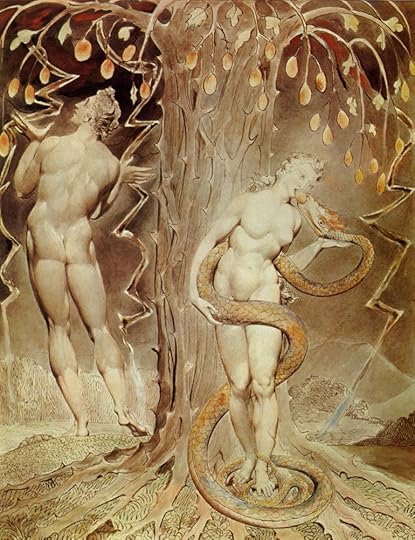 Temptation And Fall
Temptation And FallWilliam Blake
December 25, 2017
St Anastasia – An Ancient Commoration for Christmas Day
I offer the following as a complement to your celebrations of the Nativity of Our Lord, not as a replacement! Like someone whose birthday is on Christmas Day, St Anastasia is not often commemorated. A separate Mass for her can be said on December 25th, but given the unlikelihood of this happening, I suggest that perhaps in order to revive her momory, as one of the saints of the Roman Canon, we could find a way of adding a veneration to her without distracting from the Nativity – perhaps though the insertion of her name at the prayers of the day in the Mass or the Divine Office, or through a veneration of her icon in the processions in such a way that it supports, rather than distracts from the main focus of the day, the Nativity of the Lord.
Perhaps we could take a lead from the Eastern Church which always commemorates the saints of the day even in Sunday liturgy by the singing of the multiple troparia (one-verse hymns) of the day at the appropriate juncture.
Not much is know about the saint, except that she was a Roman by birth who was martyred at Sirmium in modern-day Serbia during the persecution of the Emporer Diocletian. You can read about her in New Advent here.
This Western depiction of her shows her with the idealized features of a Greek goddess as would have been the norm in the neo-classical art of, for example, the High Renaissance or of the early 19th century.

Eastern icons of her show her with a bottle as ‘deliver from potion’ symbolising the power of her prayers to cure the sick.


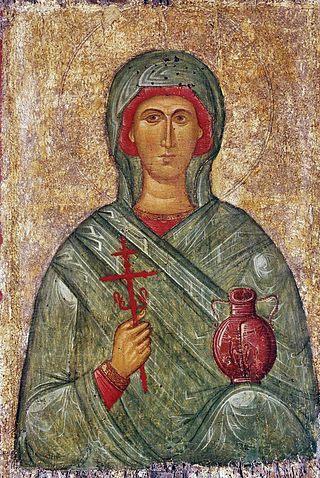
This is one of a series of articles written to highlight the great feasts and the saints of the Roman Canon. All are connected to a single opening essay, in which I set out principles by which we might create a canon of art for Roman Rite churches, and a schema that would guide the placement of such images in a church. (Read it here.) In these, I plan to cover the key elements of images of the Saints of the Roman Canon – Eucharistic Prayer I – and the major feasts of the year. I have created the tag Canon of Art for Roman Rite to group these together, should any be interested in seeing these articles as they accumulate. For the fullest presentation of the principles of sacred art for the liturgy, take the Master’s of Sacred Arts, www.Pontifex.Uni
December 22, 2017
Aesthetics for Artists and Art Lovers – Learn About Cosmic Beauty
A Survey of the Philosophy of the Good, the True and the Beautiful. An Online Course taught by Dr Carrie Gress for Pontifex University
When I first decided, many years ago now, to become an artist, I wanted to know how to create beautiful art. Given this goal, it seemed obvious, along with all the other aspects of my formation, that I should start reading about beauty itself.
However, to my surprise, I found very little to help me from Catholic writers. Books on aesthetics talked at length about the nature of beauty – and some seemed true (although many didn’t) but barely anyone seemed to offer anything that was of practical use to an artist.
Everyone told me to read Jacques Maritain. I’m probably going to commit a heresy that will offend Thomists here, but I wasn’t at all convinced by him either. As I read through Art and Scholasticism, which was admittedly, full of complex reasoning about the nature of beauty, I still wanted to ask the question: and how do I use all of this to help me judge what is beautiful? I am an artist, how is all this going help me to decide whether or not to direct the brush to the left or to the right? But there was very little there to help me.
Finally, right at the end of the book, he told us that the embodiment of all that he had been describing was in the paintings of Braques and Picasso. You have to be joking, I thought. I knew that their work was designed so as to promote an anti-Christian worldview, yet he seemed to be unaware of this. After pages and pages of proofs justifying the objectivity of beauty, in the end, even for Maritain it came down to an arbitrary application of personal taste to tell us that beauty is what he happens to like. Why not just forget the first 300 pages, I thought, and tell us that the answers to what is beautiful, is that it is what clever philosophers say it is? This principle of elitism was no different from any university in the country, where the intellectuals use wordy arguments to tell you what they like is good and you’re a Philistine if you think differently.
Although many Church Fathers had written about beauty, they didn’t treat the subject separately and so it was difficult to know where to find references to it if they were sprinkled across the whole corpus of the writings. St Thomas is one of these.
I was faced with the prospect of reading volumes and volumes of ancient works, in the hope of finding the occasional nugget of wisdom or hope that someone else had done it first. Strangely, the best anthology I could find was a coffee table book, lavishly illustrated, by an atheist who didn’t even believe in objective beauty, but nevertheless knew how to represent the arguments clearly – Umberto Eco. The book was called A History of Beauty. It had short quotations bu very little explanation.
Now, finally, we have a course by a Catholic that gives you a thorough survey of the way that beauty, along with its sisters, goodness and truth from which it can’t really be separated. It is better than anything I have seen before – taking you from the ancient Greeks right the way through to awful moderns in a systematic and clear presentation.
A Survey of the Philosophy of the Good, the True and the Beautiful is offered as part of Pontifex University’s Master of Sacred Arts program and it is taught by Dr Carrie Gress. Some of you may know her through her bestselling book, The Marian Option, or through her regular articles on various websites such as the National Catholic Register. Dr Gress is also an accomplished philosopher, who obtained her PhD in philosophy from Catholic University of America. She has done all that reading that I was baulking at! And has put it all together for the benefit of all in a stimulating and clear presentation.
Dr Gress’s wonderful online course will give you an understanding of the different ways that the great and influential figures of the past – Plato, Aristotle, St Bonaventure, St Thomas and the medievals, for example -understood what beauty is. Through this you will be able to form your own view – there is no single Catholic definition by the way, however much we might like it to be the case. Furthermore, by taking the full Master of Sacred Arts program you will understand how to apply what you learn in your own lives and work.
This an introductory philosophy course. The approach is to assume high intelligence but not necessarily a background in philosophical principles. Therefore, anyone can learn from it. She takes the trouble to explain everything from the foundation of first principles and from there guides you right up to the high peaks!
Incidentally, though clearly very important, St Thomas is not the only contributor to this story! There are many people with important and different things to say on the subject. And as Dr Gress is an expert on Jacques Maritain, you can listen to her explanation of his work and decide for yourself what you make of him – you don’t have to adopt my point of view!
You can take it as part of the Master of Sacred Arts program or as a stand-alone, for credit or audit. www.Pontifex.University. It is a recorded online course, so you can register at any time, and take it at your own pace.
The painting below is Raphael’s famous School of Athens. I suggest that given Dr Gress’s course goes from Athens right up to the present day, there isn’t a wall big enough to illustrate all the philsophers she talks about!
December 21, 2017
Cultivating Spiritual Joy! An Advent Meditation by a Priest from the Instute of the Incarnate Word
There is a series of wonderful meditations on the Claritas blog at the moment by priests from the Argentian order, the Institute of the Incarnate Word. I wanted to highlight this, and also share with you here third in the series of meditations for this third week of Advent, based upon the readings from last Sunday. It is by Father Nicholas Grace who is in Cowdenbeath in Scotland. It is so refreshing to hear a priest actually confirming something that I have long believed, that happiness is a choice we can make, provided know how to make the choice. This is simple but profound advice!
He writes:
We have a wonderful topic this 3rd Sunday of Advent because the readings the Church presents give us the opportunity to speak about that most desirable Catholic disposition of soul, that is, Spiritual joy.
The readings offer plenty of material for speaking about spiritual joy. The spiritual joy of the glad tidings that Isaiah was asked to bring to the poor or the spiritual Joy expressed in the Psalm we heard. The Psalm which was an echo of Our Lady’s Magnificat, an expression of spiritual Joy in its purest form.
However, we will focus instead on the 2nd reading from the letter of St. Paul where we are encouraged to rejoice always, to rejoice in God.
I would like to focus on three of the means Paul offers to cultivate and maintain spiritual joy. I will mention three ways to pray without ceasing, and three ways to avoid quenching the spirit. Finally, both of these means will be summarized in Paul’s admonition to retain what is good and refrain from what is evil.
First: Paul urges, pray constantly. How is this possible? It is possible in three ways.
1st: He constantly prays who does not neglect the appointed time for prayer. This begs the question, do I have an appointed time for prayer? If not, why not?
2nd: Always cultivate good desires in the heart. “Lord, you hear the desire of the meek”.
We pray for the good, we desire the good and we do the good. Prayer is always present in the good things we do. For this reason, the wise man says, “He does not cease praying who does not cease doing good.”
Therefore, to constantly cultivate good desires in the heart, is to constantly cultivate prayer.
3rd way to pray without ceasing is by giving to those in need.
In fact, the Fathers of the Church tell us: “He who always gives alms is the one who always prays, for the person who receives alms, prays for the person who gives alms.”
So, he constantly prays who does not neglect the appointed time for prayer, who cultivates a pure heart and who gives to those in need.
Second: Paul urges: do not quench the Spirit. You might ask, how does one quench the unquenchable? The Holy Spirit is indestructible but someone can drive the Spirit away from himself or can inhibit the Spirit’s operation in somebody else.
In somebody else? When somebody wishes to do something generous as a result of the impulse of the Holy Spirit and the person impedes it, he quenches the Holy Spirit.
What about in himself? We all know the answer, mortal sin. Every man is tempted, drawn away and enticed. Once enticed, sin is brought to the soul, and sin brings death and death is the departure of the Holy Spirit.
The Holy Spirit abides in us but when we commit grave and deliberate sin, he departs. Sacred Scripture says as much, “For a holy and disciplined spirit will flee from deceit, and will rise and depart from foolish thoughts, and will be ashamed at the approach of unrighteousness.” (Wis. 1:5).
Third: Paul urges us to test everything, I ask you, is this admonition not a great help to having a positive approach to what we have already said?
If we pray constantly will we fail to retain the good? If we implore the Holy Spirit to work in us, if we obey the commandments if we love our neighbor as we love our-self, will we not then refrain from evil? Will our spiritual joy not be bubbling up from inside of us?
The answer is yes, however, the more we pursue the good and fight the bad, not only will our spiritual joy be increased but so will our spiritual crosses. Crosses which we can spurn, leave or lift.
Clearly one shall be disloyal if he spurns it, negligent if he leaves it, but true-hearted if he lifts his cross. Cross-bearing is the highway of holiness because holiness bears all crosses, crosses picked up in the pursuit of the good as well as the battle against the bad, crosses which instead of being born, become embraced, embraced because those same crosses are a fount of that wonderful spiritual joy which is not the cause of holiness but a manifestation of it.
I would like to conclude by wondering out loud what would happen if St. Paul were here. Would we be nervous if he were to ask us if we knew the means to promote and preserve spiritual joy? Certainly not! Would we be nervous if he asked us what it means to pray constantly? Certainly not! for we have just heard that he who prays constantly is he who prays when he says he will, prays because he has good desires and a good heart, prays because he always gives to those with needs, those who in turn pray for him in thanks for his good deeds. Would we be nervous if Paul were to ask us what it means to quench the Holy Spirit? Certainly not! for we have just heard that, he stifles the spirit whoever prevents others from following holy inspirations, or himself follows his own wicked inclinations.
Well, we may have wicked inclinations but we will do everything to curb them, everything to retain what is good and refrain from what is evil. For we are Catholics, specially chosen by God, to give glory to God. We will be strong in faith, perseverant in hope, industrious in charity, joyful in carrying our crosses and quick to help others with theirs, for we know, that just as God has blessed us, so we must bless all persons, for all persons God loves.
The image is a fresco of St Paul by Giotto

St Paul is often protrayed as a stern man, but the account of his life and his letters have always suggested the opposite to me. There are many references to the joy of the Faith in his writing. Happiness is, after all, what we all seek, and there is no doubting from St Paul that it is on offer to Christian. I like the firm, yet gentle and peaceful expression on this painting by Giotto.
December 20, 2017
Recently Completed Sculpture by Thomas Marsh: the Holy Spouses, Patrons of the Unborn
I was delighted to receive notice of the completion of a major commission by Thomas Marsh.
It is of the Holy Spouses, Patrons of the Unborn and is located at the Shrine of Our Lady of Guadalupe in Bakersfield, CA.
I love the restrained use of color as applied to the bronze. Also, note that the faces are not portraits of a model, but rather they are idealized, taking inspiration from the Greek ideal, that was used by High Renaissance and Baroque masters. This is something that is so important in sacred art, yet is not understood by so many artists who work in naturalistic styles. I explain the reasons why idealization is important in sacred art in an earlier blog post here.
Beautiful art is as important to the creation of a culture of life as the noble political battles fought by those in the Right to Life movement, I suggest!
Below is a detail of the original clay model that the cast was based on:
Thomas has been an advisor to me in the creation of the Masters of Sacred Arts program at www.Pontifex.University, which offers the all-round formation, the Catholic inculturation that would tell an artist how to direct his brush or chisel, and a patron which artists to commission!
He is also the teacher of Deborah Samia who has created one of the two online studio classes required for the MSA program, an Introduction to Sculpting the Figure.
December 19, 2017
Anthony Visco Atelier for the Sacred Arts Announces Courses for 2018
Anyone who wants to learn to draw and paint in the naturalistic style should consider classes at the atelier of Catholic master artist Anthony Visco. The perfect combination would be to learn your practical artistic skills with Anthony at his Atelier for Sacred Arts and take the Master of Sacred Arts with www.Pontifex.University in order to have the all-round formation and Catholic inculturation that will help direct your brush…and chisel…and crayon!


December 18, 2017
William Blake’s Satan Watching The Caresses of Adam and Eve, by Bill Donaghy of the Theology of the Body Institute
A video commentary by Bill Donaghy of the Theology of the Body Institute, Here is the second in the series of 12 short videos on art by Bill Donaghy of the Theology of the Body Institute in Philadelphia.
This week and next he discusses two paintings by William Blake the poet and artist. In this case, he discusses illustrations to Milton’s Paradise Lost. First is Satan Watching the Caresses of Adam and Eve.
At first glance, the art of Blake may seem a world apart from the grand fresco of Adam and God in the Sistine Chapel by Michelangelo. However, both draw on the ancient Greek ideal of the human form for inspiration. This can be seen if you compare the paintings in each case with any Venus or Hermes (as below)

This is appropriate to the subject matter and consistent with the ideas of John Paul II because he stated that in his view the Greek ideal might be the starting point for the art of the Theology of the Body.
Here is the video:
It was recorded in April last year and so the course that Bill refers to is past, but I would encourage people to look for courses in the coming year. His approach to art and beauty is fully in harmony with that of Pontifex University and my own Way of Beauty book.

December 13, 2017
Caravaggio’s Greatest Painting!
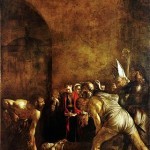 St Lucy is a 3rd-century saint, a virgin martyr who was venerated from the moment of her death and whose feast is celebrated on December 13th in both East and West. An account of her life can be found here. As with all worthy images intended for worship, we see in this portrayal of her (by the great 18th century Venetian, Tiepolo) we see an account of her story and the characteristics that identify her uniquely. So we see her receiving communion just at the moment of death caused by being stabbed in the throat. As the instrument of her death, the dagger is placed bottom right in the composition, along with her eyes on a plate. This latter symbol is most commonly associated with her, although it is developed relatively late, in the middle ages, linked to her name which is derived from the Latin word for light.
St Lucy is a 3rd-century saint, a virgin martyr who was venerated from the moment of her death and whose feast is celebrated on December 13th in both East and West. An account of her life can be found here. As with all worthy images intended for worship, we see in this portrayal of her (by the great 18th century Venetian, Tiepolo) we see an account of her story and the characteristics that identify her uniquely. So we see her receiving communion just at the moment of death caused by being stabbed in the throat. As the instrument of her death, the dagger is placed bottom right in the composition, along with her eyes on a plate. This latter symbol is most commonly associated with her, although it is developed relatively late, in the middle ages, linked to her name which is derived from the Latin word for light.  Other attributes we will see are a palm branch – which is appropriate to all martyrs – as seen in this famous Renaissance period painting by Francesco de la Cossa
Other attributes we will see are a palm branch – which is appropriate to all martyrs – as seen in this famous Renaissance period painting by Francesco de la Cossa  And, people struggling to move her. The consul Paschasius ordered that she be removed to a brothel and abused until she died. However, teams of men tried but failed to move her. We see this in the painting below in this 15th-century depiction. Teams of oxen are being used.
And, people struggling to move her. The consul Paschasius ordered that she be removed to a brothel and abused until she died. However, teams of men tried but failed to move her. We see this in the painting below in this 15th-century depiction. Teams of oxen are being used.  A tradition iconographic image has the saint holding a cross as a sign of martyrdom as in the beautiful fresco:
A tradition iconographic image has the saint holding a cross as a sign of martyrdom as in the beautiful fresco:  I finish with Caravaggio and his burial of St Lucy. This is a late painting done when he was in exile, so to speak, from Rome and living in Sicily, the home of St Lucy. It is an altarpiece and in my opinion, one of the most brilliant paintings he has done. I do not know if the stylistic development is by accident or design, but regardless I like the result. Notice how much more this reflects the developing baroque style than his early work. It is shrouded in more mystery, with disappearing edges, far more numinous monochrome rendering and less colouration than he might have painted in his youth. The composition is brilliant, with the arcs of the arcs of the limbs of the two figures in the foreground creating a mandorla, which frames the figure of St Lucy.
I finish with Caravaggio and his burial of St Lucy. This is a late painting done when he was in exile, so to speak, from Rome and living in Sicily, the home of St Lucy. It is an altarpiece and in my opinion, one of the most brilliant paintings he has done. I do not know if the stylistic development is by accident or design, but regardless I like the result. Notice how much more this reflects the developing baroque style than his early work. It is shrouded in more mystery, with disappearing edges, far more numinous monochrome rendering and less colouration than he might have painted in his youth. The composition is brilliant, with the arcs of the arcs of the limbs of the two figures in the foreground creating a mandorla, which frames the figure of St Lucy. 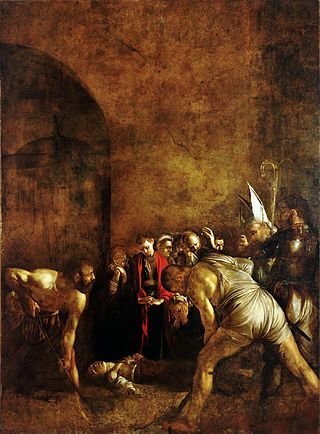 This is one of a series of articles written to highlight the great feasts and the saints of the Roman Canon. All are connected to a single opening essay, in which I set out principles by which we might create a canon of art for Roman Rite churches, and a schema that would guide the placement of such images in a church. (Read it here.) In these, I plan to cover the key elements of images of the Saints of the Roman Canon – Eucharistic Prayer I – and the major feasts of the year. I have created the tag Canon of Art for Roman Rite to group these together, should any be interested in seeing these articles as they accumulate. For the fullest presentation of the principles of sacred art for the liturgy, take the Master’s of Sacred Arts, www.Pontifex.University.
This is one of a series of articles written to highlight the great feasts and the saints of the Roman Canon. All are connected to a single opening essay, in which I set out principles by which we might create a canon of art for Roman Rite churches, and a schema that would guide the placement of such images in a church. (Read it here.) In these, I plan to cover the key elements of images of the Saints of the Roman Canon – Eucharistic Prayer I – and the major feasts of the year. I have created the tag Canon of Art for Roman Rite to group these together, should any be interested in seeing these articles as they accumulate. For the fullest presentation of the principles of sacred art for the liturgy, take the Master’s of Sacred Arts, www.Pontifex.University.
December 11, 2017
The Theology of the Body and Art, By Bill Donaghy
In the first of a series that will run for the next few weeks, here is a beautiful and simple analysis of this scene from the fresco by Michelangelo in the Sistine Chapel in Rome. It is presented by Bill Donaghy of the Theology of the Body Institute in Philadelphia. The Institute offers a series of intensive classes for a certificate on the writings of St John Paul II, which I recommend wholeheartedly. They focus especially on their relevance to the culture and the New Evangelization, as well as marriage and the family. In this five-minute presentation, we see all three come together!
John Paul II was a great admirer of Michelangelo and his style. He suggested that idealized naturalism, which draws on the ancient Greek ideal, might be a way to represent mankind ‘naked without shame’.
December 6, 2017
Why the Prophet Daniel and The Fiery Furnace Is So Important for Christians.
Have a look at this ancient wall painting of the prophet Daniel’s companions in the fiery furnace. It is from the Roman catacombs and is one of the images that is included in the Catechism of the Catholic Church.
Scripture tells us of the fate of Daniel’s three friends (Daniel 3: 49, Knox translation). It says that an ‘angel of the Lord had gone down into the furnace with Azarias and his companions and drove the flames away from it, making a wind blow in the heart of the furnace, like the wind that brings the dew. So that these three were untouched, and the fire brought them no discomfort. Whereupon all of them, as with one mouth, began to give praise and glory and blessing to God, there in the furnace.’ Afterwards, the king who had thrown the youths into the fire, Nebuchnudnezah said he saw four figures, and the fourth was ‘as it had been a son of God’ (v92).
I recently examined this passage in scripture because the song that the three subsequently sang is known as the Canticle of Daniel and is sung on Feast days at Lauds. I was looking at the background to this and considering why it is sung in the liturgy.
My understanding is that in the interpretation of the Church Fathers, the reference to the wind and the dew in the scriptural account has been connected to the Creation story in which the Spirit of God was over the water, and then to the baptism of Christ in which the Holy Spirit comes down and the sacrament of baptism is initiated. Baptism is, through water, the instrument of the death of the old self spiritually so that we can be resurrected, also spiritually, in Confirmation or Chrismation by the action of the Holy Spirit.
There is a similar connection to the passages describing the crossing of the Red Sea and the crossing of the Jordan by Joshua, in which the water and wind are connected. Wind is the action of the Spirit, as is fire (as at Pentecost which the Church Fathers also connected to the burning bush).
These common themes are the reason why traditionally in baptistries we would see portrayals of all these scenes, as described here.
So who is the fourth figure?
He can be represented simply as ‘an angel of the Lord’, as in this contemporary icon by Nicola Saric:
Some Church Fathers identified the figure as a pre-incarnational appearance of Christ, as in the tale of the three figures in the Hospitality of Abraham in Genesis, and the voice in the Burning Bush speaking to Moses. So in this icon, this is made explicit by the artist. The ‘IC XC’ and the cross in the icon tell us that this is Christ.
The painting in the catacomb we referred to initially seems not to show either of these. Rather, he appears not to be showing the fourth figure at all, but is giving us something else, It is a bird. The branch in the beak of the bird suggests to me that the artists is connecting it to the dove in the story of Noah. This story of Old Testament redemption is connected to the new through that image of the dove, who appears at the Baptism of the Lord.
This is an event, of course, that opens the way for our salvation. This New Testament resurrection in the spirit is available to all men through the Church, right now in this life, and is every bit as miraculous and wonderful as the saving of the three youths. We are partaking of the divine nature and the living out of the sacramental life of the Church which opens the way to a life of the greatest joy, if only we could believe it. The artist is connecting all of these events together through this painting, and it is why, I suggest, it would be appropriate for a baptistry in order to help deepen our faith.
There is something else that occurs to me. My understanding is that bodily resurrection is referred to by Peter as a process of purification by fire, in so doing he is echoing Wisdom 3 and Malachi 3. Again this is a purification by the Spirit.
The passage from Malachi 3: 1-4, refers to the purification by fear but begins as follows: ‘See where I am sending an angel of mine, to make the way ready for my coming. All at once the Lord will visit my temple; that Lord, so longed for, welcome herald of the divine covenant. Ay, says the Lord of hosts, he is coming; but who can bear the thought of that advent? Who will stand with head erect at his appearing? He will put men to a test fierce as the crucible…’
This same passage in Malachi is the one quoted directly to also in Matthew 11.10. In this Matthew tells us that John the Baptist is this messenger (angelos) who shows us the Christ.
Here is an icon of John the Baptist, also known as the Forerunner, painted by Dr Stephane Rene, who works in the neo-Coptic school. We can see he is portrayed as an angelos - a messenger in the manner of an angel along with the Baptism of Christ and the Holy Spirit appearing as a dove:
So the angel of the Lord in the furnace of Daniel could be conceived also, I suggest, as a type for John the Baptist.
Regardless of the precise aspect of the theology that each artist has decided to portray, the full story that they reveal really should give us cause to praise God daily, just as the youths did, and sing their canticle in the Liturgy of the Hours!
The Psalms in Words, Images and Prayer is an elective course for the Master’s in Sacred Arts, offered by Pontifex University, www.Pontifex.University.
David Clayton's Blog
- David Clayton's profile
- 4 followers





